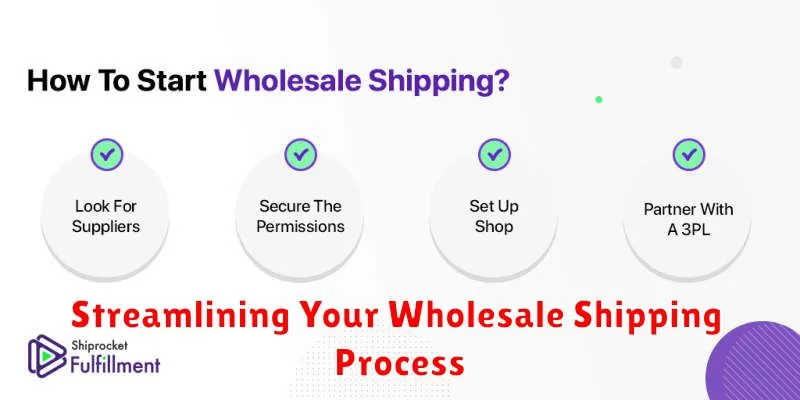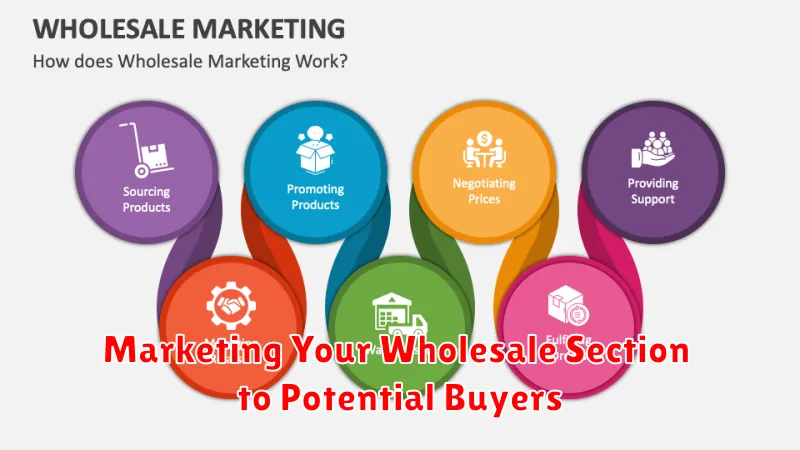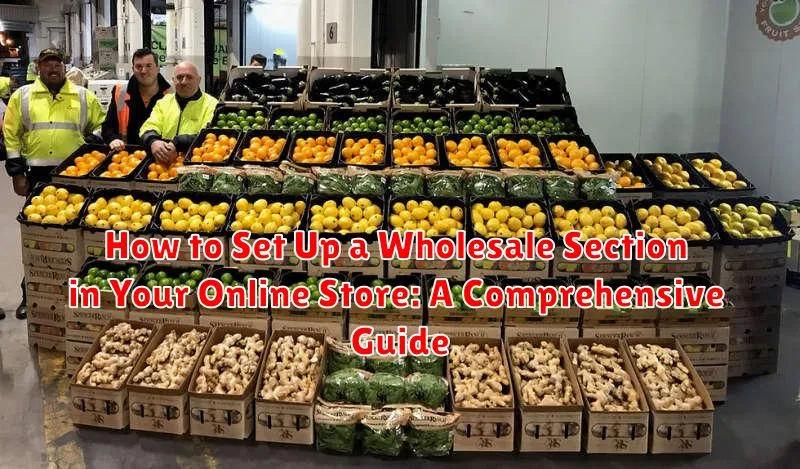Looking to expand your business and reach a wider audience? Setting up a wholesale section in your online store can be a game-changer. This comprehensive guide will provide you with a step-by-step approach to creating a successful wholesale program, covering everything from choosing the right platform and setting wholesale pricing to managing wholesale orders and building strong relationships with wholesale customers. Whether you’re selling physical products, digital goods, or services, understanding how to effectively manage wholesale operations within your existing online store is crucial for maximizing profitability and achieving sustainable growth. Learn how to streamline your wholesale business and unlock new revenue streams.
This guide is designed for businesses of all sizes, from small startups to established enterprises, seeking to implement or optimize their wholesale strategies. We’ll explore the key considerations involved in setting up a wholesale section, including platform selection, pricing strategies, order management, customer relationship management, and marketing. By the end of this guide, you’ll have the knowledge and tools necessary to confidently launch and manage a profitable wholesale section in your online store, driving growth and expanding your market reach. Discover how to leverage the power of wholesale to scale your business and reach new heights of success.
Understanding the Benefits of a Wholesale Section
Adding a wholesale section to your online store can significantly benefit your business growth and revenue. It opens up new avenues for sales and allows you to reach a wider customer base.
Increased Sales Volume: Wholesale partnerships naturally lead to larger order volumes compared to individual retail sales. This higher volume translates directly into increased revenue streams and improved inventory turnover.
Expanded Market Reach: By partnering with wholesalers, you extend your brand’s reach to new markets and demographics that you might not be able to access through direct retail efforts alone. This broadened market presence enhances brand visibility and potential for future growth.
Streamlined Order Fulfillment: Processing fewer, larger wholesale orders can be more efficient than managing numerous individual retail transactions. This streamlined fulfillment process often reduces administrative overhead and simplifies logistics.
Stronger Business Relationships: Cultivating relationships with wholesale partners fosters a sense of shared success and mutual growth. These partnerships can contribute to a more stable and predictable revenue stream.
Identifying Your Target Wholesale Customers
Before launching your wholesale section, it’s crucial to identify your ideal wholesale customer. This understanding will inform your pricing strategies, marketing efforts, and overall wholesale program structure. Defining your target wholesale audience involves considering several key factors.
First, consider the type of business they operate. Are they small boutiques, large retail chains, or online marketplaces? Different business types have different needs and order volumes. A small boutique may only need a few items, while a larger retailer may require bulk orders.
Next, consider their customer base. Understanding who your wholesale customer sells to can help you determine product fit and potential demand. If your wholesale customer targets a high-end market, your products should align with that demographic.
Finally, research their purchasing habits. Do they prioritize price, quality, or a combination of both? Understanding their purchasing behavior will inform your pricing and discount strategies, helping you create a compelling offer.
Choosing the Right Platform and Tools
Selecting the appropriate platform and tools is crucial for a successful wholesale section. Your choice depends on your existing e-commerce setup, budget, and specific wholesale needs.
If you already have an online store, consider extensions or plugins that add wholesale functionality. Many platforms offer these, allowing you to manage both retail and wholesale operations seamlessly.
For new ventures or those seeking a dedicated wholesale solution, specialized B2B platforms are an excellent option. These platforms often offer features tailored to wholesale, like tiered pricing, minimum order quantities, and quick order forms.
Regardless of your platform choice, consider integrating essential tools. Inventory management software can help track stock levels and automate reordering. Automated email marketing tools can streamline communication with wholesale clients. Finally, a robust payment gateway is essential for secure transactions.
Carefully evaluate the features and pricing of different options to find the best fit for your business.
Setting Up Wholesale Pricing and Discounts
Establishing a clear and effective pricing strategy is crucial for your wholesale section. Percentage discounts are a common approach, offering a fixed percentage off retail prices for wholesale orders. For example, you might offer a 20% discount for orders exceeding 50 units or a 30% discount for orders over 100 units.
Tiered pricing is another effective method. This involves creating different pricing tiers based on order volume. Higher order quantities unlock greater discounts, incentivizing larger purchases. Clearly display these tiers and corresponding discounts in your wholesale section.
Consider offering volume discounts on specific products or product categories. This can help clear out excess inventory or promote particular items. You can also implement early payment discounts to encourage prompt payment from wholesale clients. For instance, offer a small percentage discount if payment is received within a specific timeframe.
Ensure your chosen platform supports the implementation of these various discount structures. Clarity in your pricing and discount presentation is essential for attracting and retaining wholesale customers.
Creating a Wholesale-Specific Order Form
A dedicated wholesale order form streamlines the ordering process for your wholesale clients and ensures accurate order fulfillment. This form should be distinct from your regular retail checkout process.
Key features to include in your wholesale order form:
- Clear product identification: Use SKUs or product codes for easy order processing.
- Wholesale pricing display: Show tiered pricing based on order volume or customer group.
- Minimum order quantities: Clearly state any minimum order requirements.
- Order quantity fields: Allow for bulk quantity input.
- Shipping and handling calculations: Provide accurate shipping cost estimates or options.
- Payment options: Offer suitable payment methods for wholesale transactions, such as bank transfers or net terms.
- Tax exemptions: Include fields for reseller permits or tax exemption documentation.
Consider incorporating a quick order form that allows clients to quickly enter SKUs and quantities, simplifying the process for repeat orders.
Integrating this form with your inventory management system is crucial for real-time stock updates and automated order processing.
Managing Inventory for Wholesale and Retail
Effectively managing inventory is crucial when operating both wholesale and retail channels. Inventory visibility is paramount. You need a clear picture of stock levels to avoid overselling or understocking.
Consider implementing a dedicated inventory management system. This system should track stock movement across both retail and wholesale, providing real-time updates. Accurate tracking prevents fulfilling retail orders with stock allocated for wholesale clients, and vice-versa.
Establish separate stock locations, whether physical or virtual, within your inventory system. This allows for better organization and simplifies tracking dedicated wholesale inventory. Regular stocktaking is essential to reconcile physical inventory with system records, identifying and addressing any discrepancies promptly.
Strategically set reorder points for both retail and wholesale items. Wholesale orders typically involve larger quantities, so factor this into your reorder calculations to avoid stockouts. Lead times from suppliers should also be considered to ensure timely replenishment.
Streamlining Your Wholesale Shipping Process

Efficient shipping is crucial for wholesale success. Streamlining your processes saves time and money, contributing directly to your bottom line. Consider these strategies to optimize wholesale order fulfillment:
Packaging Optimization: Standardize packaging for different order sizes. This allows for quicker packing and potentially lower shipping costs through negotiated rates with carriers.
Shipping Software Integration: Integrate your online store with shipping software. This automates label creation, tracking information updates, and often provides discounted shipping rates.
Carrier Negotiation: Establish relationships with multiple carriers to leverage competitive pricing based on volume and destination. Don’t be afraid to negotiate for better rates as your wholesale volume increases.
Clear Shipping Policies: Clearly communicate your shipping policies to wholesale customers. This includes order processing times, shipping options, and associated costs. Transparency builds trust and reduces inquiries.
Order Tracking and Notifications: Provide customers with real-time order tracking and delivery notifications. This proactive approach enhances their experience and reduces anxiety about shipment status.
Marketing Your Wholesale Section to Potential Buyers

Effectively marketing your wholesale section is crucial for attracting potential buyers. Targeted outreach is key. Identify businesses that align with your product offerings and reach out directly via email or phone. Craft a compelling wholesale proposal outlining your products, pricing tiers, and minimum order quantities.
Industry events and trade shows offer excellent networking opportunities. Participating in these events allows you to connect with potential buyers in person, showcase your products, and build relationships. Online directories specifically designed for wholesale businesses can also broaden your reach. List your business on relevant platforms to increase visibility among wholesale buyers.
Leverage the power of social media marketing. Create dedicated social media profiles for your wholesale business and share engaging content, such as product updates and testimonials. Consider using targeted advertising campaigns to reach specific buyer demographics. Finally, ensure your wholesale section is easily accessible on your website, with clear calls to action inviting buyers to contact you for more information.
Providing Excellent Customer Service to Wholesale Clients
Providing top-notch customer service is crucial for building strong relationships with wholesale clients and ensuring repeat business. Responsiveness is key. Promptly answer inquiries, process orders, and address any concerns.
Dedicated Support can significantly enhance the wholesale experience. Consider a dedicated customer service representative or team specifically for wholesale clients. This personalized approach allows for quicker resolutions and a deeper understanding of their unique needs.
Clear Communication is essential throughout the entire process. Keep clients informed about order status, shipping updates, and any potential delays. Proactive communication fosters trust and prevents misunderstandings.
Flexible Policies, such as streamlined return processes or customized payment options, can further demonstrate your commitment to customer satisfaction. Adapting to the specific needs of wholesale clients can set you apart from the competition.
Legal and Tax Considerations for Wholesale
Navigating the legal and tax landscape for wholesale operations is crucial for a successful business. Separate legal structures may be beneficial for wholesale and retail arms of your business, offering liability protection and simplifying accounting. Consult with a legal professional to determine the best structure for your specific situation.
Tax obligations differ significantly for wholesale. Sales tax generally doesn’t apply to wholesale transactions if the buyer provides a valid resale certificate. Ensure you are collecting and remitting the correct taxes in your jurisdiction. Additionally, understand the implications of income tax on wholesale profits, which may be subject to different rates than retail income.
Contracts are vital in wholesale. A well-drafted wholesale agreement outlines terms, pricing, payment schedules, and liabilities, protecting both you and your buyers. Clearly define minimum order quantities, return policies, and other crucial aspects of the wholesale relationship.

